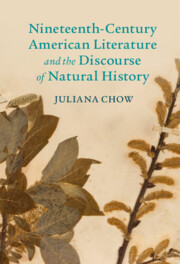Book contents
- Nineteenth-Century American Literature and the Discourse of Natural History
- Cambridge Studies in American Literature and Culture
- Nineteenth-Century American Literature and the Discourse of Natural History
- Copyright page
- Contents
- Figures
- Acknowledgments
- Introduction
- Chapter 1 Sketching American Species: Birds, Weeds, and Trees in Audubon, Cooper, and Pokagon
- Chapter 2 “Because I see—New Englandly—”: Emily Dickinson and the Specificity of Disjunction
- Chapter 3 Coral of Life: James McCune Smith and the Diasporic Structure of Racial Uplift
- Chapter 4 Thoreau’s Dispersion: Writing a Natural History of Casualties
- Afterword: &
- Notes
- Index
- Recent Books in This Series (continued from page ii)
Chapter 4 - Thoreau’s Dispersion: Writing a Natural History of Casualties
Published online by Cambridge University Press: 16 November 2021
- Nineteenth-Century American Literature and the Discourse of Natural History
- Cambridge Studies in American Literature and Culture
- Nineteenth-Century American Literature and the Discourse of Natural History
- Copyright page
- Contents
- Figures
- Acknowledgments
- Introduction
- Chapter 1 Sketching American Species: Birds, Weeds, and Trees in Audubon, Cooper, and Pokagon
- Chapter 2 “Because I see—New Englandly—”: Emily Dickinson and the Specificity of Disjunction
- Chapter 3 Coral of Life: James McCune Smith and the Diasporic Structure of Racial Uplift
- Chapter 4 Thoreau’s Dispersion: Writing a Natural History of Casualties
- Afterword: &
- Notes
- Index
- Recent Books in This Series (continued from page ii)
Summary
This chapter on Henry David Thoreau puts in relief the ecological commons and historiography of nature that issue from the environmental relations illustrated by the sketch. Connecting Thoreau’s Cape Cod to his “Dispersion of Seeds,” the chapter describes these relations in terms of the dispersal that follows from waves rising and receding upon the shore and tossing up weeds, corpses, and all kinds of salvage materials left from shipwrecks. The sketch’s seeing—and enacting—of relation as a littoral erosion and disintegration presents an alternate sense of how one lives with, pressed up against, familiarly or strangely, other species and races. If a romantic ecology might envision relations in the form of an interconnected cobweb, Thoreau’s late manuscripts release those slight silky threads to the air and lets them fly apart and ray out prismatically. This chapter follows how Thoreau’s sketches embody the ways in which text becomes a natural history of casualty, attending to species and race, and engaging with them by way of an environmental optics. The tenuous lines of sight draw a partial ecology that stretches and cleaves the liminalities between “nature” and Thoreau’s “I,” even as it disperses those very entities.
Keywords
- Type
- Chapter
- Information
- Publisher: Cambridge University PressPrint publication year: 2021



